Life History and Fecundity of Mountain Whitefish from Utah Streams
The Utah Cooperative Fishery Research Unit was jointly sponsored by the U.S. Fish and Wildlife Service, Utah Division of Wildlife Resources, and Utah State University.
Abstract
This paper describes aspects of the life history of mountain whitefish Prosopium williamsoni from a high-elevation stream, the West Fork of Blacks Fork River, Utah (2,835–2,926 m), and summarizes fecundity of mountain whitefish from five northeastern Utah streams (Blacks Fork, Blacksmith Fork, Logan, Provo, and Weber rivers). The standing crop of mountain whitefish in a 0.14-ha reach of the Blacks Fork River was 224.5 kg/ha or 2,375 fish/km. These fish attained a maximum age of 12 years and grew from a mean total length of 72 mm at age 1 to 347 mm at age 12, growing more slowly than fish from other stream populations. Spawning in Blacks Fork River began in mid-October. All males were sexually mature by age 4 (181 mm or longer); females reached sexual maturity at 201–251 mm (ages 5–7). The ratio of mature males to females was 1.6:1. Fecundity (772–4,860 eggs) was correlated to female body size (215–361 mm and 86–372 g, respectively). Fecundity of 190 mountain whitefish from the five streams was also positively correlated with fish size and was similar for fish of comparable sizes from all five streams. Variation in fecundity of individual fish increased with fish size. From size-grouped data, predicted fecundity for mountain whitefish increased by total length from 350 eggs for females averaging 217 mm to 11,844 eggs at 437 mm and by weight from 1,171 eggs for females averaging 86 g to 17,083 eggs at 1.1 kg. These results were consistent with fecundity of mountain whitefish from other locations in western North America.
Introduction
Mountain whitefish Prosopium williamsoni are found in cold streams and lakes in mountain areas of western North America from the northern Lahontan Basin in Nevada to the Yukon–British Columbia border (Lee et al. 1980; Scott and Crossman 1973). In the United States this species occurs in Nevada, Utah, Colorado, Wyoming, Montana, Oregon, and Washington, and in Canada it occurs in Alberta and British Columbia.
Although various aspects of the life history of mountain whitefish have been reported (Carlander 1969; Daily 1971), the life history of fish from high-elevation streams has not been reported, and fecundity among streams has not been compared. The objectives for this study of mountain whitefish were (1) to describe age and growth, sexual maturity, fecundity, and standing crop in a high-elevation stream in Utah; and (2) to summarize fecundity from five Utah streams and compare those results with other populations in western North America.
Methods
All mountain whitefish were collected from a 0.16-km reach of the West Fork of Blacks Fork River located in the Uintah Mountains of northeastern Utah at an elevation of 2,835–2,925 m. All whitefish were collected on October 12, 1977, by using by brickets of sodium cyanide, which is lethal to mountain whitefish (at the 1 mg/L concentration used) and not size selective (Wiley 1984). A 0.14-ha section of the stream was blocked with small-mesh seines at the upper and lower ends of the reach (9.1 m average width), which ensured complete collection of all mountain whitefish (N = 383) in the study reach. The reach contained typical pool and riffle habitats found in high-elevation streams of western North America.
To compare fecundity among Utah streams I collected mature female mountain whitefish (N = 122) with a battery-powered backpack electrofisher (Smith-Root Type XI) from four additional Utah streams between mid-October to mid-November 1977: the Blacksmith Fork, Logan, Provo, and Weber rivers, located in the Wasatch Mountains of northeastern Utah at elevations of 1,524–1,676 m. Females were selected to cover the size range of mature fish just before spawning, when maturing eggs were still intact in the ovaries.
Fish from all five locations were measured to the nearest millimeter total length (TL) and weighed to the nearest gram. Regression equations to estimate fecundity from total length or weight were calculated (SSPS 1997). Standard and fork lengths were also taken from Blacks Fork River mountain whitefish because all sizes were collected. To allow comparisons of fecundity based on standard and fork lengths in the literature, regression equations were calculated to convert total length into either standard or fork length. In addition, all fish from the Blacks Fork River were autopsied to determine sex and maturity.
Scale samples from Blacks Fork River whitefish were taken midway between the origin of the dorsal fin and the lateral line. Plastic impressions of four or five scales were magnified at 30× with a microprojector, and the distances to each annulus and edge were measured along the anterior scale radius. A body-scale relationship was calculated and used to determine total lengths of individual fish at the end of each growing season (Summerfelt and Hall 1987).
Ovaries were removed from each mature female, wrapped in cheesecloth with an identification label, and preserved in 10% formalin. Maturing eggs could be easily distinguished by their large size and yolk color. Maturing eggs were separated from the ovarian tissue and counted in subsamples of approximately 10% of the ovary weight. Maturing eggs from ovaries and subsamples were blotted with paper towels to remove excess liquid and weighed to the nearest 0.01 g. The fecundity (i.e., total number of maturing eggs) of mountain whitefish was determined as a proportion of the egg number in a sample to the weight of eggs in the entire ovary. A mean percentage error for estimating fecundity, using the gravimetric method, was determined from total egg counts in ovaries from five females. Separation of eggs from the ovarian connective tissue reduced the error in estimating fecundity with the gravimetric method. The percentage error, using a 10% sample compared to total egg counts, averaged +3.9 (ranged from +2.4 to +4.8). This mean value was used to correct all fecundity estimates from subsamples. Regression equations were calculated for the total number of eggs contained in individual females by total length and weight. In addition, the predicted fecundity and 95% confidence interval were calculated for fish that were grouped by 25-mm intervals of length (SPSS, Inc. 1997). Estimated fecundities were compared for selected total lengths of fish from Utah, Montana, and Alberta. Relative fecundities were calculated as the number of mature eggs per kilogram of female weight and compared with low and high values for fish from other locations. Mean egg diameters for individual females were determined from 30 eggs aligned in a trough. The eggs were rearranged and measured two more times, to account for any irregularities in their basic spherical shape, and averaged. The three measurements were added together and divided by 90 to obtain the mean egg diameter for individual females.
Results
Aspects of Mountain Whitefish Life History
Mountain whitefish from the 0.16-km reach of the Blacks Fork River represented, I believe, the overall population in this high elevation stream for the following reasons. Fish of all ages (1–12) were found in this reach, suggesting that the population was a resident stock. This population was relatively unexploited because of its remoteness in the Uintah Mountains, so older fish had not been appreciatively removed by anglers. Habitat in the reach included pools and riffles with gravel, cobble, and boulder substrates that was natural and diverse. All whitefish were collected from the reach using a chemical that was not size selective (Wiley 1984), in contrast to selectivity reported for other sampling gear (Lagler 1971).
Conversion of various lengths
Based on measurements of mountain whitefish in the Blacks Fork River, fork lengths (FL) were estimated from total lengths (TL) with the regression equation FL = 0.938 TL − 1.34 (r = 0.999, N = 383). Standard lengths (SL) were estimated from total lengths with the regression equation SL = 0.853 TL − 0.699 (r = 0.993, N = 383). By rearranging the values in these regression equations, total lengths can also be calculated from standard or fork lengths.
Age and growth
I believe the scale method was a valid determiner of Blacks Fork River mountain whitefish age because annuli were clearly visible, even in the oldest fish. A strong relation (r = 0.98, N = 383) between scale radius (SR) and total length was calculated: TL = 1.38·SR(30) + 22.5. Most (81%) of the scale samples could be easily read and were used in growth analyses. Annual growth was considered complete because tight spacing of circuli occurred at the scale edge of fish. Comparisons of back-calculated growth for individual fish demonstrated that growth was similar for males and females, so these data were combined. The oldest fish collected (age 12) averaged 347 mm TL; the age-1 fish averaged 72 mm (Table 1). Growth increments were largest in the youngest fish and decreased in older fish, which is consistent with fish growth in the north temperate zone. The regression equation for the length–weight (WT) relation for mountain whitefish from the Blacks Fork River was logeWT = 2.98(logeTL) − 11.56 (r = 0.99, N = 383).
Sexual maturity and sex ratios
All male mountain whitefish in the Blacks Fork River reached sexual maturity by age 4, when they were 181 mm TL or longer (Table 2). Females first reached sexual maturity when they exceeded 200 mm TL, and all were mature at 251 mm TL (ages 5–7). The sex ratio at 181 mm (length at first maturity) or longer was 1.6 males to 1 female.
Spawning season
Of 73 mature mountain whitefish females collected in the Blacks Fork River, 5 (7.4%) were spent by October 12. The youngest one had completed 6 growing seasons, three had completed 7, and one had completed 12. Based on egg development in maturing females, the spawning season was probably from mid-October to mid-November.
Fecundity
Fecundity of mountain whitefish from the Blacks Fork River was positively correlated with increasing length of females (Figure 1). The number of maturing eggs was estimated to be 772 (215 mm TL) to 4,860 (361 mm TL). Females of the same length but different ages produced nearly identical numbers of maturing eggs. The fecundity also increased with increasing weight of individual females: 772 eggs (86-g fish) to 4,860 (372-g fish). The regression equation E = 12.1 WT + 144 (r = 0.91, N = 68) described the relationship between fecundity (E) and weight of females.
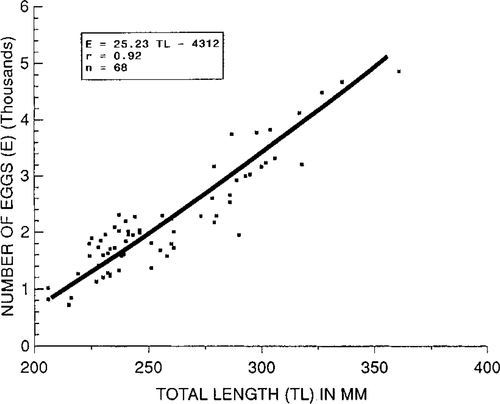
Relation of fecundity to total length for mountain whitefish from the West Fork of the Blacks Fork River, Utah, October 1977
Standing crop
The standing crop of mountain whitefish in the Blacks Fork River was 224.5 kg/ha or 2,375 fish/km of stream. A total of 383 mountain whitefish were collected from the 0.16-km study reach or 95.3% of the fish community by number. The standing crop of all fish in the reach was 227 kg/ha, of which mountain whitefish composed 98.9%, brook trout Salvelinus fontinalis 0.7%, mottled sculpin Cottus bairdi 0.3%, and cutthroat trout Oncorhynchus clarki 0.2%.
Mountain Whitefish Fecundity in Five Streams
The mean diameter of 30 maturing eggs for individual mountain whitefish from the five sampled Utah streams ranged from 2.34 mm for a 217-mm TL fish to 2.66 mm for a 437-mm fish. In general, the mean egg diameter was positively related to fish length.
Mature mountain whitefish collected before the spawning season provided reliable fecundity values because maturing eggs were nearly fully developed and few ripe eggs remained in spent whitefish (Thompson and Davies 1976). The fecundities of mountain whitefish from all five Utah streams were similar for fish of a given total length (Figure 2) or weight (Figure 3) and were positively correlated with fish size. The range in fecundity for mountain whitefish from Utah streams increased from 772 eggs (215-mm TL, 86 g fish) to 24,136 eggs (458-mm, 1,260-g fish). Variation in fecundity of individual females increased with increasing length and weight of individual fish. Predicted mean fecundity from size-grouped data were positively related to size, as calculated by regression analyses: 350 eggs for fish averaging 217 mm TL to 11,844 eggs for 437-mm fish (Table 3) and 1,171 eggs for fish averaging 86 g to 17,083 eggs for 1.1-kg fish (Table 4).
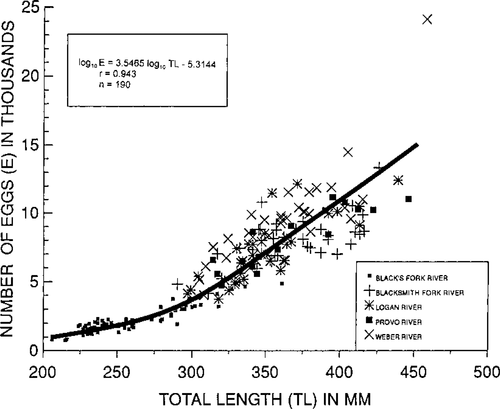
Relation of the number of ripe eggs to total length for mountain whitefish from five northeastern Utah streams, fall 1977
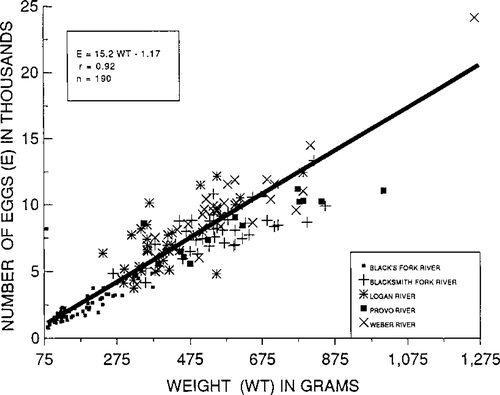
Relation of the number of ripe eggs to weight (WT) for mountain whitefish from five northeastern Utah streams, fall 1977
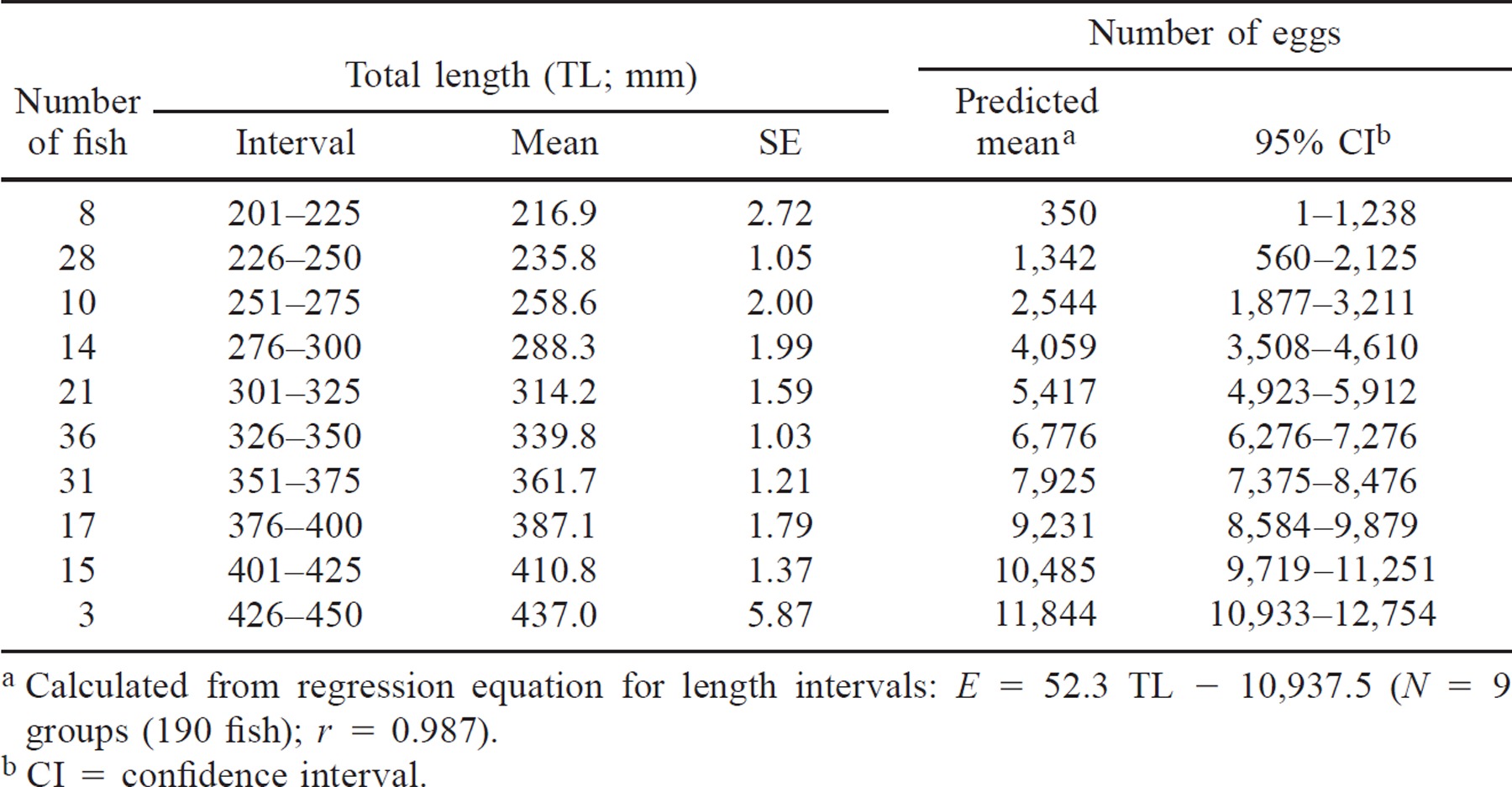
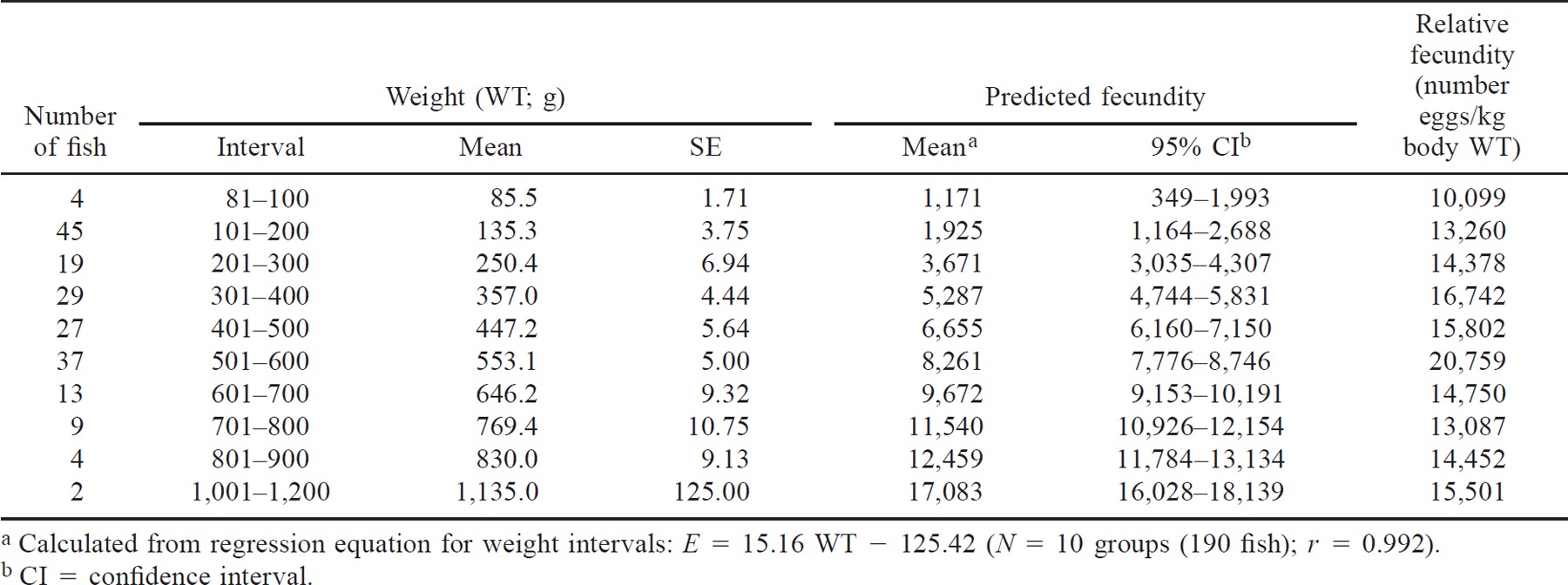
The mean relative fecundity of mountain whitefish for the five Utah streams was 15,041 eggs/kg body weight. No trend was apparent by size-group of fish (Table 4). Relative fecundity ranged from 12,978 (Black Forks River) to 17,143 (Logan River) eggs/kg body weight among the five individual streams.
Discussion
Aspects of Mountain Whitefish Life History
Age and growth
Mountain whitefish from the Blacks Fork River grew slower than did those from other stream populations in from Alberta, Idaho, Montana, and Utah (Table 5). Whereas these other populations were from migratory fluvial stocks, the Blacks Fork River whitefish may have been a resident stock. Faster growth of fluvial stocks was attributed to migration to lower elevation, warmer temperatures, and greater productivity during the growing season. Mountain whitefish in the Blacks Fork River study reach included ages 1–12; that, and because the reach was near the system's headwaters, suggest a resident stock.
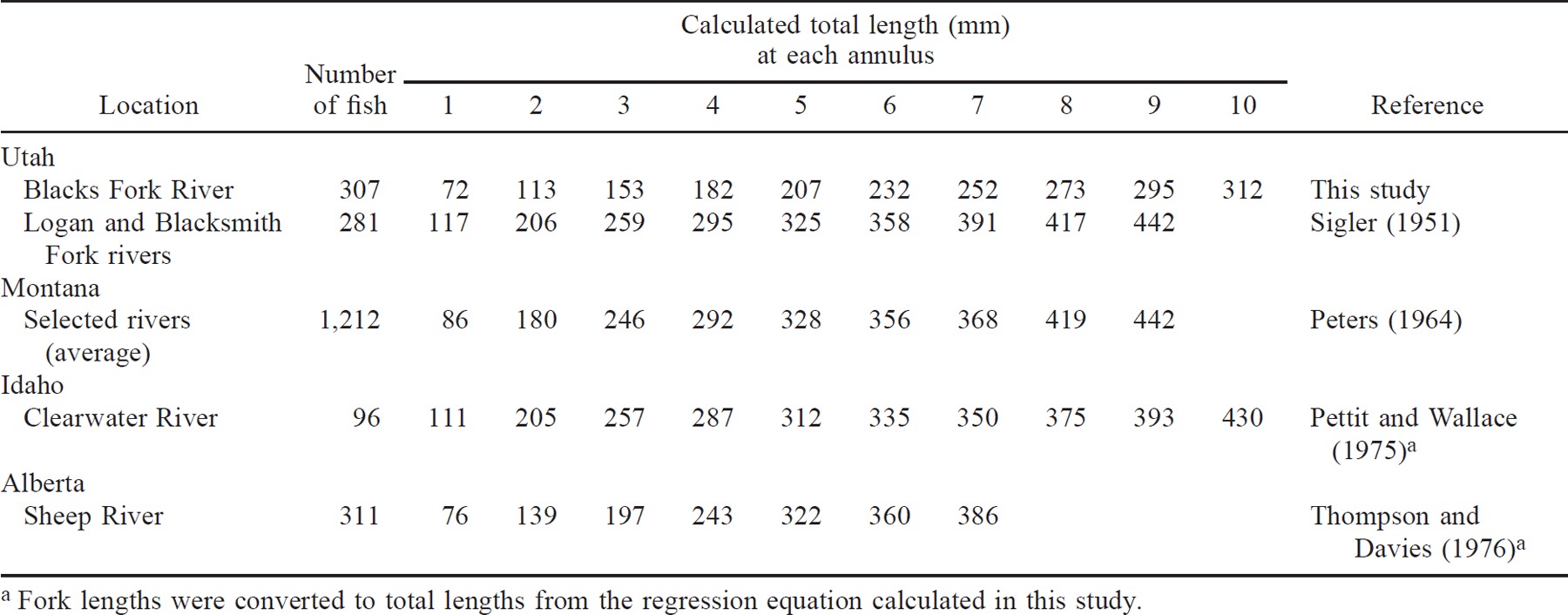
Mountain whitefish from the Blacks Fork River weighed less at length than did those from the Logan River, Utah (Sigler 1951). Weights from the length–weight relationship were estimated for fish of selected lengths from the Blacks Fork River and the Logan River (Sigler 1951). The weight differences between the two streams became more pronounced with increasing fish length; Blacks Fork whitefish weighed 11.7% less than Logan River whitefish at 200 mm TL and 16.8% less at 350 mm.
Spawning season
Several mountain whitefish in the Blacks Fork River at (elevation 2,835–2,926 m) spawned by mid-October, whereas fish at lower elevations (1,524–1,676 m) in the Logan River spawned during late November and early December (Sigler 1951). None of the fish collected between mid-October to mid-November from the Blacksmith Fork, Logan, Provo, and Weber rivers were ripe. However, the spawning season of mountain whitefish from the Blacksmith Fork, Provo, and Weber rivers probably occurred at the same time as the Logan River because the elevations were similar. In other parts of its range, mountain whitefish generally spawn in the fall between October and December, when the water temperature declined from 7.2°C to 4.4°C (Carlander 1969). The differences in spawning time for mountain whitefish in Utah was attributed to differences in water temperature as related to stream elevation. Mountain whitefish spawned earlier in the Blacks Fork River, a high-elevation stream where the water temperature declined earlier in the year, than they did in streams at lower elevations.
Sex ratio
The higher proportion of males (1.6:1) in the Black Forks River is probably related to salmonid behavior. Salmonid males generally occupy spawning areas earlier than females and remain there during the entire spawning season, whereas females move into spawning areas, spawn, and move to wintering areas soon after spawning.
Standing crop
The mountain whitefish standing crop of 224.5 kg/ha in the Blacks Fork River (elevation about 2,900 m) was lower than the standing crop of 293.7–390.0 kg/ha in the Logan River (elevation about 1,524 m; Ottenbacher 1980). The Blacks Fork River standing crop of 2,375 fish/km was at the lower end of the range (148 and 65,893 fish/km) reported for streams in other studies. In a valley reach of the Blacksmith Fork River standing crop estimates of mountain whitefish were 148–2,468 fish/km in a channeled reach and 3,315–5,440 fish/km in a more natural reach (Ottenbacher 1980). In a canyon reach of the Logan River, Bridges (1963) reported 1,002 fish/km and 1,636 fish/km in 2 consecutive years. The highest density of mountain whitefish reported in the literature was 65,893 fish/km for the upper Green River, Wyoming (Binns 1972). This wide range in standing crop is due to a number of factors, primarily the type of stock, type and condition of habitat at the site sampled, degree of human alteration, and season for migratory stocks.
Mountain Whitefish Fecundity in Five Streams
Size of maturing eggs
The mean diameters of maturing eggs in mountain whitefish from the five Utah streams were 2.34–2.66 mm, and diameters were positively related to fish length. These mean egg diameters were similar to those (2.54 mm) for ripe mountain whitefish eggs from the Sheep River, Alberta (Thompson and Davies 1976).
Fecundity and water productivity
Although fish productivity (standing crops and growth rates) is directly related to total alkalinity of water (Moyle 1956), fecundity did not appear to be affected by total alkalinity. Alkalinities of high-altitude streams in northeastern Utah, such as the Blacks Fork River, are about 80–90 mg/L, whereas averages at lower elevations are more than twice those at a higher elevation (e.g., Blacksmith Fork River 203 mg/L, Logan River 189 mg/L, Weber River 172 mg/L [Roy Gunnel, Utah Department of Environmental Quality, personal communication]).
Fecundity in different locations
Fecundities of mountain whitefish from Alberta, Montana, and Utah were similar (Table 6); estimated respective fecundities for fish 300 mm TL were 3,258, 2,851, and 2,959 eggs and for fish 400 mm were 8,023, 8,594, and 8,207 eggs. The variability between locations was attributed to sample sizes, range of female lengths, and whether data were analyzed by individual fish or grouped by fish size. The range of relative fecundities reported from different locations varies between 11,598 and 17,143 eggs/kg body weight. The mean relative fecundity for the five Utah streams was 15,041 eggs/kg body weight (range 12,978–17,143) for the individual streams, which is between the low value of 11,598 reported for fish from the Sheep River, Alberta (Thompson and Davies 1976) and the high value of 17,143 reported for fish from the Logan River in this study.
Acknowledgments
William Geer, Lynn Kaeding, and George McGaughlin, Utah Division of Wildlife Resources, provided mountain whitefish from the Blacks Fork River. Charles R. Berry assisted in collecting mountain whitefish from the Blacksmith Fork, Logan, Provo, and Weber rivers. Comments from Donald Archer, Utah Division of Wildlife Resources, N. Allen Binns, Wyoming Game and Fish Department, Gary Larson, U.S. Geological Survey, and three anonymous reviewers were helpful in revising this paper.







